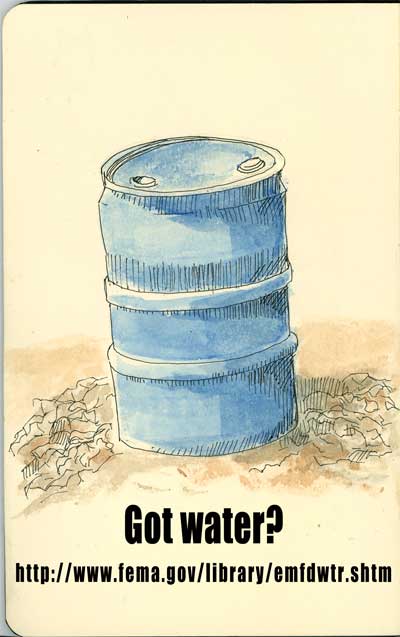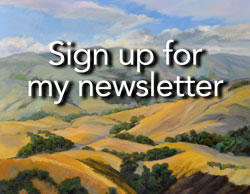What I did today – and why you should do it, too
If you found your way here because of my blatant blog-pimping today on the Everyday Matters list, I apologize for the hype.
On second thought: nope, I don’t apologize at all. However you got here, I’m glad that you did, and I hope you’ll read on and start taking action today.
We live in Southern California, prime earthquake territory. There’s a good chance that there will be another big earthquake somewhere in LA in my lifetime, and I, for one, don’t want to die of thirst waiting for help to come if the major pipelines bringing water into LA rupture. Or the reservoirs break. Or both.
I gave up believing that FEMA would come to my rescue long ago; last week’s tragedy just confirmed my concern.
So, every so often — like today — we empty our blue barrel of its water, clean it out, put in the correct amount of bleach and seal ‘er back up again.
We are fortunate to live in a house where we have a place to store a barrel. If you live in an apartment or condominium, you can store water in 5 gallon plastic bottles or rinsed out soft drink bottles and put them in a cool, dry place out of the light. You should also have emergency water, clothing and food in your car; you may not be home if disaster strikes.
Whether your part of the world makes you vulnerable to hurricanes, floods, earthquakes, blizzards or tornadoes, prepare yourself for the unique hazards they represent. Don’t wait.
Even if you are living in one of the rare areas that seems to escape natural disasters, ANY city is vulnerable to a terrorism and having enough water and food to get along until help comes is not just a good idea, it’s essential. If you’re one of those optimistic folks who believes nothing bad will happen, or that the US government (local, state or federal) will come running in and rescue you in time if it does, I have a bridge across Lake Ponchartrain I’d like to sell you. Bottom line: plan to be on your own.
So, here’s what I’d like you to do:
Go to this link FEMA EMERGENCY FOOD AND WATER SUPPLY LIST and print out the information and put it in a safe place. If there’s a disaster and the power’s out or your laptop battery dies, it will be too late.
Print out this link, too: Red Cross Emergency Plan PDF with supply list
Get your emergency supplies together starting today, including some food (remember babies and pets as well as adults/kids) extras of essential medicines and that most crucial supply: water. You can get barrels like this from emergency supply stores as well as from local soft drink bottling companies (they are used for storing soft drink syrup in.)
Have an evacuation plan for you and your loved ones, with an out of state contact for coordination in case you get separated.
Know how to ‘shelter in place’ and protect yourself for the weather or geological hazards in your area. Both those links are filled with life-saving information that you can’t afford to ignore, especially if you have children or dependent elders counting on you.
Stay safe friends, OK? I want to see your drawings for a long, long time.
We now return to our regularly scheduled programming of watercolor, Rapidoliners, Moleskines and puppy dogs. And I thank you for your attention.





lindsay
September 5, 2005
Karen, this is a very timely public service announcement. Thanks for the reminder. It’s been on my mind to do the emergency plan and to pack stuff away.
Maggie
September 5, 2005
Thanks for the great tips, I remember all too well living in CA and storing water and food. Hmm, now living in
midwest in tornado alley I should be doing the same and haven’t yet. Best get cracking.
Jori Lynn
September 5, 2005
And don’t forget to pack drawing implements.
Karen
September 5, 2005
Lindsay, Maggie and Nita – yes, the time is right to start making those preparations. As an old dear friend of mine says “you can’t see around life’s corners …”
Jori Lynn — good idea – we need to take care of our mental health too!
Linda
September 5, 2005
Great advice, Karen! I’d also add to the list a camera (and film) and a road map of your city- those may be on the lists you provided links to but I didn’t see them when I took a quick look. I think the map is really important because after the Northridge quake when some freeways and roads were closed, it was hard to figure out how to get home when our usual routes were closed.
Aravis
September 6, 2005
This is all excellent information and tips. Great idea, Karen!
Linda
September 6, 2005
Karen, thanks for this great information. We are doing much the same thing here. My daughter, who works in human resources for a large company in Florida, was telling me about folks moving there and finding temporary jobs and homes who were having great difficulty because of lack of documentation. One woman was going to rent an apartment, but couldn’t get electricity because she did not have a copy of her last power bill. Its the silly little things that we don’t think about.
Jim
September 6, 2005
Karen, Great idea and accompanying informationt. We live in a place the government found most safe in the 1940’s to build nuclear reactors for plutonium production: the desert of eastern Washington. People who live here are known to highly identifiable as they glow in the dark. There are no earthquakes, no hurricanes, no toronadoes, not even much rain here. We do, however, have two dormant and one not so dormant volcanoes directly west of us (St. Helens, Rainier,and Adams). Guess the government just can’t think of everything.